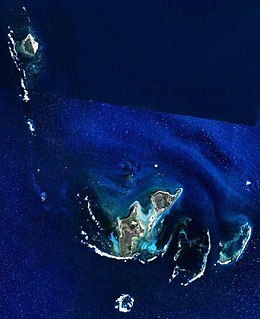Alexander Island is the largest island in Antarctica.
Alexander Island, which is also known as Alexander I Island, Alexander I Land, Alexander Land, Alexander I Archipelago, and Zemlja Alexandra I, is the largest island of Antarctica. It lies in the Bellingshausen Sea west of Palmer Land, Antarctic Peninsula from which it is separated by Marguerite Bay and George VI Sound. George VI Ice Shelf entirely fills George VI Sound and connects Alexander Island to Palmer Land. The island partly surrounds Wilkins Sound, which lies to its west. Alexander Island is about 390 kilometres (240 mi) long in a north-south direction, 80 kilometres (50 mi) wide in the north, and 240 kilometres (150 mi) wide in the south. Alexander Island is the second largest uninhabited island in the world, after Devon Island.
Alexander Island may also refer to:
- Alexander Island (Nunavut)
- Alexander Island (Collie River), an island in the Collie River, Western Australia
- Alexander Island (Fitzroy River), an island in the Fitzroy River, Western Australia
- Alexander Island (Houtman Abrolhos), an island in the Houtman Abrolhos, Western Australia
- Rakahanga, formerly called Alexander Island in the Cook Islands
- Alexander Island (Texas) in Houston Texas
- Alexander Islands, in the Russian Arctic

Alexander Island is one of the Canadian arctic islands located in Nunavut, Canada. It lies south of Massey Island and Île Marc, and north of Bathurst Island. Located at 75°52'N 102°37'W it has an area of 484 km2 (187 sq mi), 42.8 kilometres (26.6 mi) long and 19 kilometres (12 mi) wide.
Alexander Island is a 5.4 hectare island in the Collie River, Western Australia. It is located at 33°18′44″S115°42′3″E, a few hundred metres east of the Collie Bridge in Australind, a suburb of Greater Bunbury.

Alexander Island in the Kimberley region of Western Australia is the area of land between the two arms of the Fitzroy River from where the river splits, about 10 kilometres south of Fitzroy Crossing, to where the arms merge about 80 kilometres south-west of Fitzroy Crossing.
| This disambiguation page lists articles about distinct geographical locations with the same name. If an internal link led you here, you may wish to change the link to point directly to the intended article. |






